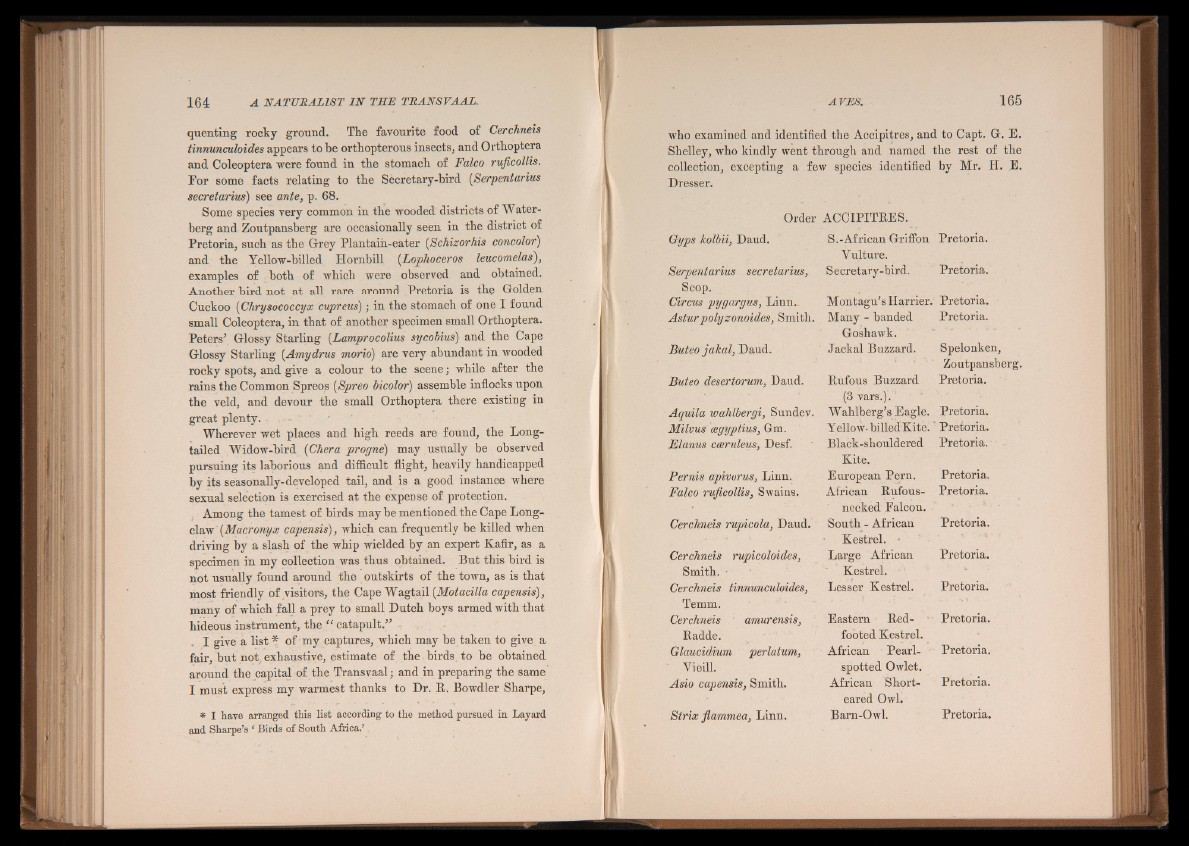
quenting rocky ground. The favourite food of Cerchneis
tinnunculoides appears to he orthopterous insects, and Orthoptera
and Coleoptera were found in the stomach of Falco ruficollis.
For some facts relating to the Secretary-bird (Serpentarius
secretarius) see ante, p. 68.
Some species very common in the wooded districts of Water-
berg and Zoutpansberg are occasionally seen in the district of
Pretoria, such as the Grey Plantain-eater (Schizorhis concolor)
and the Yellow-billed Hornbill (Lophoceros leucomelas),
examples of both of which were observed and obtained.
Another bird not at all rare around Pretoria is the Golden
Cuckoo (Chrysococcyx cupreus); in the stomach of one I found
small Coleoptera, in that of another specimen small Orthoptera.
Peters’ Glossy Starling (Lamprocolius sycobius) and the Cape
Glossy Starling (Amy dr us morio) are very abundant in wooded
rocky spots, and give a colour to the scene; while after the
rains the Common Spreos (Spreo bicolor) assemble inflocks upon
the veld, and devour the small Orthoptera there existing in
great plenty.
Wherever wet places and higb reeds are found, the Longtailed
Widow-bird (Chera progne) may usually be observed
pursuing its laborious and difficult flight, heavily handicapped
by its seasonally-developed tail, and is a good instance where
sexual selection is exercised at the expense of protection.
Among the tamest of birds may be mentioned the Cape Long-
claw (Macronyx capensis), which can frequently be killed when
driving by a slash of the whip wielded by an expert Kafir, as a
specimen in my collection was thus obtained. But this bird is
not usually found around the outskirts of the town, as is that
most friendly of visitors, the Cape Wagtail (Motacilla capensis),
many of which fall a prey to small Dutch boys armed with that
hideous instrument, the “ catapult.” -
I give a list* of my captures, which may be taken to give a
fair, but not exhaustive, estimate of the birds to be obtained
around the capital of the Transvaal; and in preparing the same
I must express my warmest thanks to Dr. R. Bowdler Sharpe,
* I have arranged this list according to the method pursued in Layard
and Sharpe’s ‘ Birds of South Africa.’
who examined and identified the Accipitres, and to Capt. G. E.
Shelley, who kindly went through and named the rest of the
collection, excepting a few species identified by Mr. H. E.
Dresser.
Order ACCIPITRES.
Gyps kolbii, Daud. ' S.-African Griffon
Yulture.
Serpentarius secretarius, Secretary-bird.
Scop.
Circus pygargus, Linn. Montagu’s Harrier
Asturpolyzonoides, Smith. Many - banded
Goshawk.
Buteo jakal,J)a,\id. Jackal Buzzard.
Buteo desertorum, Daud.
Aquila wahlbergi, Sundev.
Milvus cegyptius, Gm.
Elanus cceruleus, Desf.
Pernis apivorus, Linn.
Falco ruficollis, Swains.
Cerchneis rupicola, Daud.
Cerchneis rupicoloides,
Smith. •
Cerchneis tinnunculoides,
Temm.
Cerchneis ' amurensis,
Radde.
Glaucidium perlatum,
Vieill.
Asio capensis, Smith.
Strix flammea, Linn.
Rufous Buzzard
(3 vars.).'
Wahlberg’s Eagle.
Yellow- billed Kite.
Black-shouldered
Kite.
European Pern.
African Rufousnecked
Falcon.
South - African
Kestrel. •
Large African
Kestrel.
Lesser Kestrel.
Eastern Red-
footed Kestrel.
African Pearl-
spotted Owlet.
African Shorteared
Owl.
Barn-Owl.
Pretoria.
Pretoria.
Pretoria.
Pretoria.
Spelonken,
Zoutpansberg.
Pretoria.
Pretoria.
: Pretoria.
Pretoria.
Pretoria.
Pretoria.
Pretoria.
Pretoria.
Pretoria.
Pretoria.
Pretoria.
Pretoria.
Pretoria.